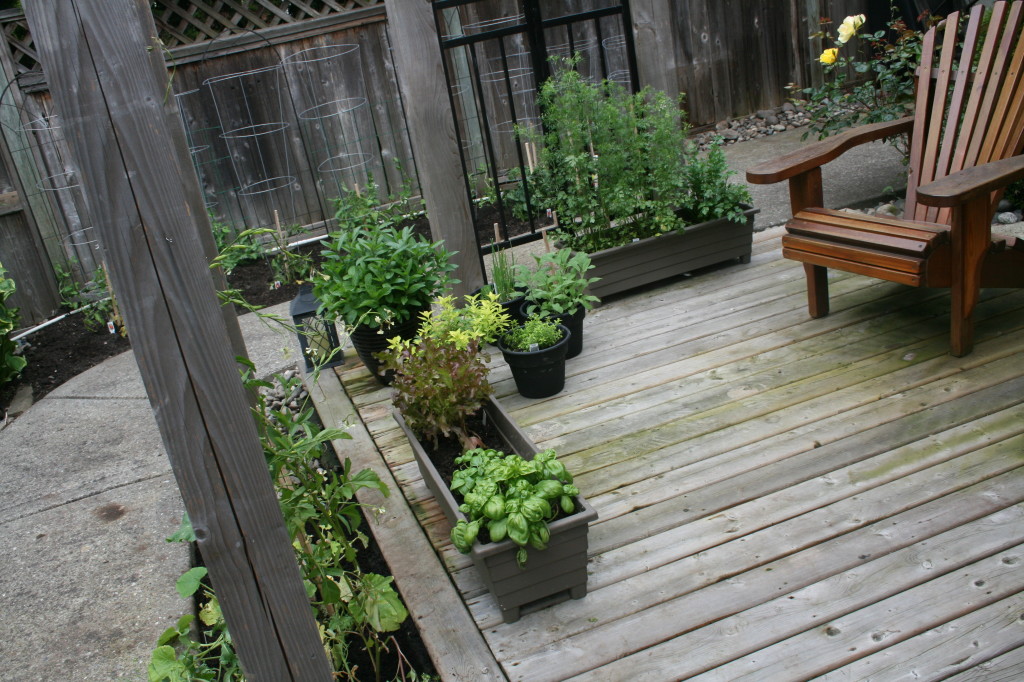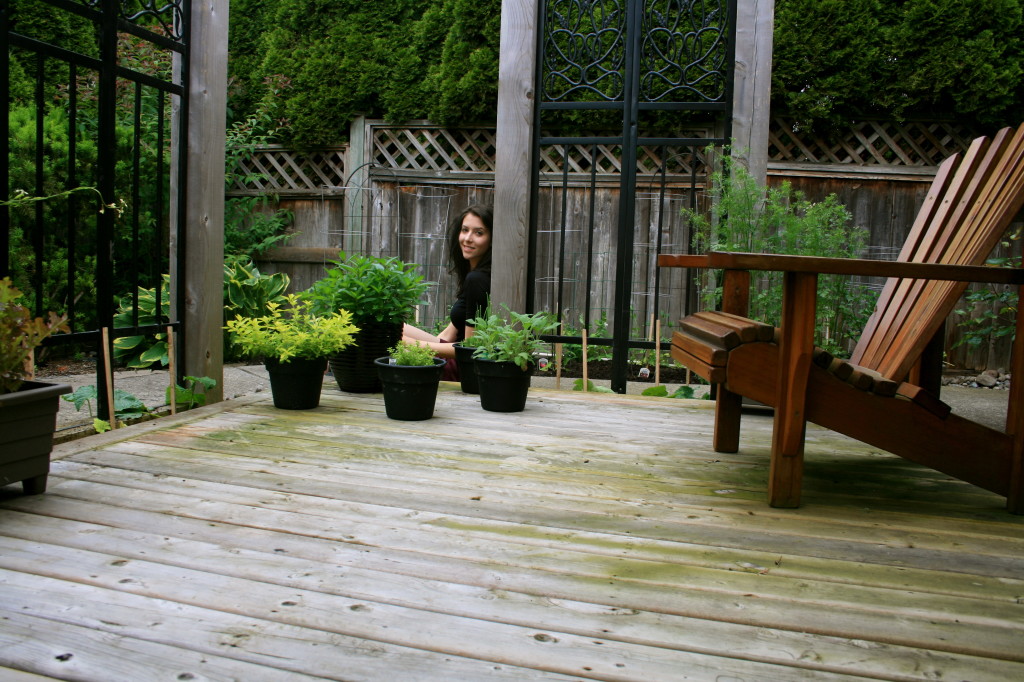 I think that one of the root causes of the obesity epidemic and skyrocketing rates of diseases caused by poor lifestyles (like diabetes and cardiovascular disease) is our general disconnection from the food we eat. We go to the store and it is all packaged very prettily, the vegetables have little to no dirt, the meats are quite indistinguishable from their original forms, free of feathers and all their other parts, nuts and seeds are already shelled and beans are free from their husks. Another root cause of our heart breaking and avoidable mass health inflictions is our disconnection from ourselves. We live in a fast paced world and nearly everyone suffers from some kind of chronic stress and there is rarely enough time to do everything that needs to be done.
I think that one of the root causes of the obesity epidemic and skyrocketing rates of diseases caused by poor lifestyles (like diabetes and cardiovascular disease) is our general disconnection from the food we eat. We go to the store and it is all packaged very prettily, the vegetables have little to no dirt, the meats are quite indistinguishable from their original forms, free of feathers and all their other parts, nuts and seeds are already shelled and beans are free from their husks. Another root cause of our heart breaking and avoidable mass health inflictions is our disconnection from ourselves. We live in a fast paced world and nearly everyone suffers from some kind of chronic stress and there is rarely enough time to do everything that needs to be done.
One of the ways I try to fight these issues in my own life is through gardening. Being able to feed yourself something that you grew from nothing awakens a very primal sense of accomplishment. When you realize how hard it is to supply even just one meal, or one salad, your appreciation for food grows immensely. Plus, the time it takes to weed and water whatever you grow affords you a few quiet moments of peace away from the rest of the world. For me, nature is where I go to distress, to reconnect, to feel small and realize that my problems are insignificant, that they will pass and that everything will change. In nature, these changes are starkly obvious in the seasonal cycles of the trees and the short life spans of the insects. When you garden you have to pay attention to these cycles. The beauty of gardening is that it is so versatile and adaptable. There is some kind of plant that will grow in nearly any condition.
My love of gardening comes from my dad and his dad. They both have always been strong, large men, the kind of men that you don’t challenge too often if you know what’s good for you. Yet they could still play like happy children can, their love and passion for life always seemed most evident to me outside, goofing around in the yard. Luckily my dad is still around to help me out and make sure I don’t plant the wrong things in the wrong areas. For those with attention spans long enough to read labels, the backs of the little markers that come with plants will tell you if it flourishes in full sun or with some shade and if it does well with plain soil or with extra fertilizers and manure.
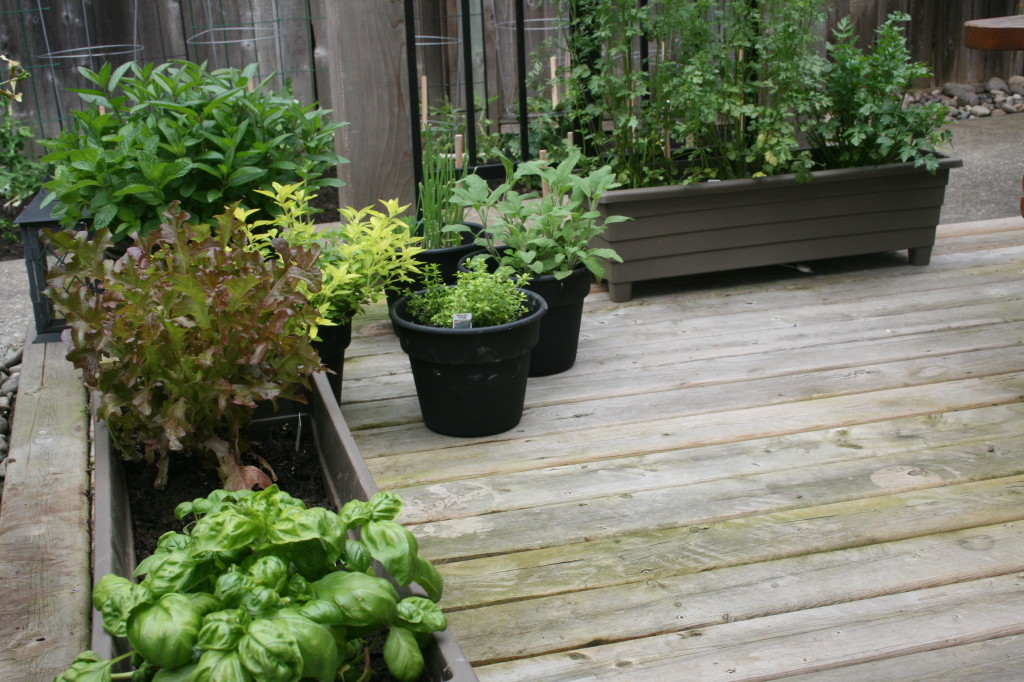 This is my main herb section, I first got these pots when I lived in an apartment and needed something narrow enough to fit on the patio railing. This spot used to have a hot tub but now it is kind of a no man’s land- perfect for filling up with pots. Most of these were planted at the same time and I take from them in pretty equal amounts but the mint in the back left corner is unarguably the biggest and densest.
This is my main herb section, I first got these pots when I lived in an apartment and needed something narrow enough to fit on the patio railing. This spot used to have a hot tub but now it is kind of a no man’s land- perfect for filling up with pots. Most of these were planted at the same time and I take from them in pretty equal amounts but the mint in the back left corner is unarguably the biggest and densest.
Mint is definitely the easiest to grow in my opinion, it is even more reliable than the weeds. It is very hardy and basically grows itself, it does well with lots of sun but will grow well basically anywhere. It is best in its own pot, otherwise it will take over any neighbors. There are many varieties, some extra special ones have a hint of chocolate or lemon in the taste. The leaves are essential for mojitos and they also make soothing tea with hot water and a bit of honey if desired. Mint also pairs nicely with darker meats like lamb and adds some zest to smoothies. Basically, all herbs do well in pots, or some container, even tiny mason jars work, when out on a patio or in a windowsill that gets some sun. Chives grow long and tall like thick blades of grass, with a slight onion flavor, sweet basil leaves are as beautiful as flowers and add a delicacy to salads, cheese, meats and grains. Thyme adds fresh earthiness to and oregano livens up cooked meats and seafood. If you don’t know what kind of herbs you like, go to the nursery, take a leaf of each plant delicately between your index finger and thumb and rub it lightly to release the oils. Smell it and if the fragrance appeals to you, the taste probably will too.
I find that the next easiest to grow after herbs is kale, it comes in several varieties and it is sturdy enough to last through frosts, not many other plants can boast of that. It grows roots fast and really anchors in, and the leaves replenish quickly.
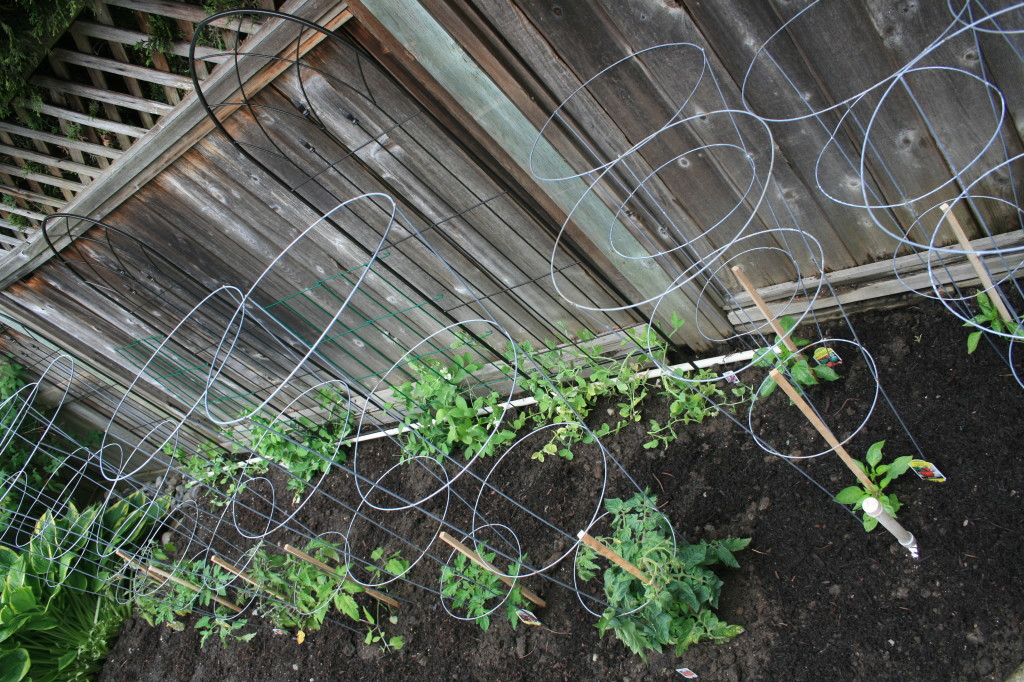 This is a long, narrow section along the side fence, there are six tomato plants along the front with a row of peas and green beans behind. Off to the right are five pepper bushes. Using cages and trellises, plus wooden stakes next to the base of the plants helps them to grow upwards and stay sturdy, so they require less surface area but still mature well.
This is a long, narrow section along the side fence, there are six tomato plants along the front with a row of peas and green beans behind. Off to the right are five pepper bushes. Using cages and trellises, plus wooden stakes next to the base of the plants helps them to grow upwards and stay sturdy, so they require less surface area but still mature well.
If you have a spot with lots of sun then tomatoes will give you good return on your investment, they come in so many flavors and sizes. I like to experiment with heirloom varieties, some are yellow and some are purple and they all have strong, rich flavors. They can be grown in a large pot or in the ground, just make sure to get a cage for them to support the vines as they grow.
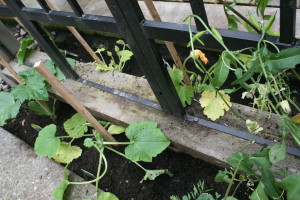
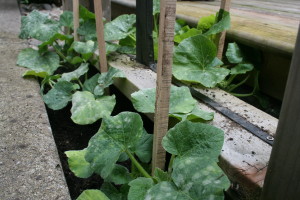 These are from the base of one of the large pillars I am leaning against in the top photo. We originally installed these for roses but two of them did not survive the winter so I took them over and put vegetables in instead. The top one has salad greens, zucchini and long cucumbers (vine, not bush varieties are needed for climbing). The bottom one has butternut and acorn squash. All of these items climb well but the vegetables are heavy so it is good to use a really strong and well supported trellis. They each would need a lot of space on the ground but they actually do quite well when grown vertically, their large leaves air out better and they usually have much less chance of growing fungus or getting infested with insects.
These are from the base of one of the large pillars I am leaning against in the top photo. We originally installed these for roses but two of them did not survive the winter so I took them over and put vegetables in instead. The top one has salad greens, zucchini and long cucumbers (vine, not bush varieties are needed for climbing). The bottom one has butternut and acorn squash. All of these items climb well but the vegetables are heavy so it is good to use a really strong and well supported trellis. They each would need a lot of space on the ground but they actually do quite well when grown vertically, their large leaves air out better and they usually have much less chance of growing fungus or getting infested with insects.
If you want something sweeter then strawberries are a good place to start, they can take over pretty quickly so I kept mine in a pot this year but they grow really well straight in the ground.
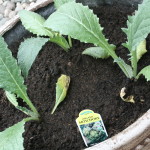
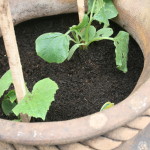
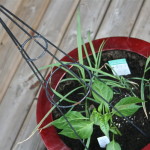
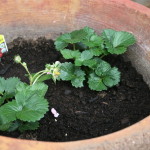 Top to bottom is artichokes, small pickling cucumbers with stakes for support, lemongrass and a jalapeño plant with a baby cage, then strawberries.
Top to bottom is artichokes, small pickling cucumbers with stakes for support, lemongrass and a jalapeño plant with a baby cage, then strawberries.
When growing vegetables and fruits in pots it is best to get ones that have holes on the bottom for good water drainage, otherwise the soil can become too saturated which is not good for the plants. Alternatively, if you are using pretty large pots that do not have any holes, you can put a layer of sand and/or a bunch of egg and fist sized rocks on the bottom so that there is space for the extra water to move around. This also helps cut down costs on soil. Worms are really good at breaking up the dirt, which helps the plants grow well over time, if you have only pots and no yard to borrow them from, go hunting on the sidewalks in the morning or after a rain to find some and bring them home to your pots. If that grosses you out, that step can be omitted, or you can hire some neighborhood children to do it.
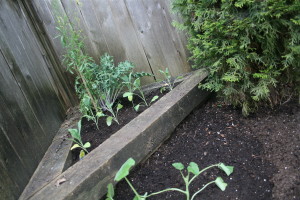
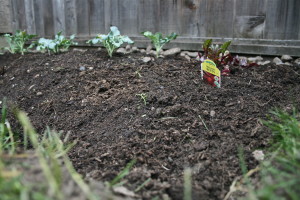 These are two far corners of the yard that only get morning sunlight, so they are better for plants that prefer colder weather and do not need full sun. The top is kale with a baby pumpkin on the lower level (I meant to buy a normal sized pumpkin for jack-o’-lanterns in October but got the wrong plant and by the time I realized my mistake I was already too attached to it to make an exchange). The bottom is a patch where we ripped out the lawn and it is now home to beets, broccoli and cauliflower.
These are two far corners of the yard that only get morning sunlight, so they are better for plants that prefer colder weather and do not need full sun. The top is kale with a baby pumpkin on the lower level (I meant to buy a normal sized pumpkin for jack-o’-lanterns in October but got the wrong plant and by the time I realized my mistake I was already too attached to it to make an exchange). The bottom is a patch where we ripped out the lawn and it is now home to beets, broccoli and cauliflower.
If possible I do recommend getting organic and pesticide free options as much as possible- for the plants, the soil and the fertilizer. I have found that the best and most cost effective places for these are local nurseries. I have tried some hardware stores as well but I wasn’t impressed with their quality or prices. Since the nutrients of a plant are dependent on the quality of soil I would rather go for the organic options than the one that says it will grow my plants several times as big- I’m not sure what kind of sketchy fertilizers are in that one, if the plants have all the nutrients they need then they will grow plenty big enough. I use a mixture of organic soil, with some handfuls of organic compost and a handful or two of organic fertilizer for everything. It’s a good sign if the ingredients are listed on the packaging. For the tomatoes I also used some extra lime, which comes in a box and can be found with the regular fertilizers. I have made the mistake of using too much fertilizer before and learned the hard way that more is not always better.
When it comes to pots and trellises I have found the best selections and reliability at local nurseries but several hardware stores have had better prices. Rod iron trellises are quite expensive but they hold up well for many years, the smaller wire cages are a few dollars each but they rust and weaken over time and need to be replaced every year or two. There are several wood options that look quite nice and more natural, they range from around $20-50 depending on the size. They do not last as well as the iron options but they should work for a few years, depending on they type of wood used and if the part underground has been treated before it was planted. It pains me a little to say this as I have a strong aversion to using plastic unless necessary but there are lots of good options in plastic too which are cost effective and highly durable.
You can take two approaches to setting up a garden, no matter how small. Buy what jumps out at you and learn as you go, or do some research online about your region and which plants tend to grow well in which seasons. My favorite resource is the people around- talk to neighbors about what they are growing, ask farmers at the market if they have any secrets to whatever crop you particularly enjoy, ask the people that work at the nurseries (or other shoppers around) for tips and advice. One of the greatest things about hobbies, gardening included, is how it can be a tool to connect with and share with others.
